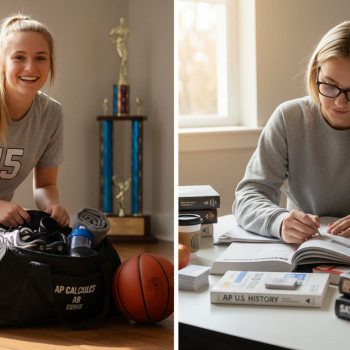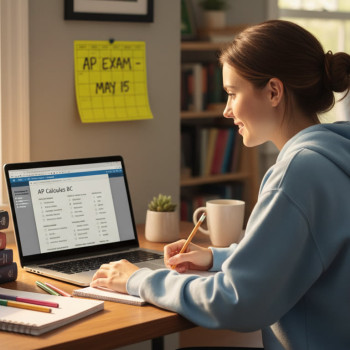Why UIUC Grainger Should Be on Your Radar — and How AP Math/CS Fit In
If you or your student is dreaming about a top engineering education, the University of Illinois Urbana‑Champaign’s Grainger College of Engineering often sits near the top of the list. It’s a place known for strong fundamentals, hands‑on research, and graduates who go on to design, build, and lead. But getting from a hopeful high schooler to a competitive Grainger applicant takes intentional preparation — and that’s where AP math and computer science courses become powerful allies.
This post is written for students and parents: practical, humane, and real-world. You’ll get actionable study habits, course sequencing, and application strategies focused on AP Calculus, AP Statistics, and AP Computer Science. I’ll also point out where one‑on‑one help (for example, Sparkl’s personalized tutoring) can make a measurable difference when it matters most.
Start with the Why: What AP Math and CS Actually Do for Your Application
AP courses do more than look good on a transcript. For engineering hopefuls they show two simple things:
- Academic readiness: AP Calculus and AP Computer Science demonstrate you can manage college‑level quantitative work.
- Intentionality: Taking a rigorous math/CS track tells admissions you’re serious about engineering.
Beyond admissions, AP classes build the toolbox you’ll use on day one at Grainger: differential equations flavors the way you understand physical systems, discrete math and algorithms shape your approach to coding problems, and AP Statistics strengthens experimental thinking. Those are habits of mind — not just bullet points.
Reality Check: AP Scores Aren’t the Only Thing
It’s tempting to chase 5s across the board. That’s useful, but admissions readers also look at course selection relative to what’s available at your school, the consistency of your workload, extracurriculars that connect to engineering (robotics, research, internships), and essays that make a human case for your interest. AP scores help, but they’re a piece — not the whole puzzle.

Suggested High School Course Pathway for Aspiring Grainger Students
Below is a sample 4‑year sequence that balances rigor and depth. Not every student will follow this exactly — use it as a template and adjust to your school’s offerings and your personal pace.
| Year | Math/CS Focus | Recommended APs | Why It Helps |
|---|---|---|---|
| 9th Grade | Build algebraic and problem‑solving foundations | None (Honors Algebra/Geometry) | Establishes a strong base for later calculus |
| 10th Grade | Advanced algebra, pre‑calculus, intro to programming | AP Computer Science Principles (if available) | Exposes student to computational thinking and project work |
| 11th Grade | Dive into calculus and algorithmic thinking | AP Calculus AB or BC, AP Computer Science A | Demonstrates readiness for engineering math and coding |
| 12th Grade | Advanced math and applied subjects | AP Calculus BC (if not taken earlier), AP Statistics, AP Physics | Reinforces modeling, data analysis, and physical intuition |
How to Choose Between AP Calculus AB and BC — and AP Statistics
Students often wonder whether to take AB, BC, or both, and where AP Statistics fits. Here’s a simple framework:
- AP Calculus AB is an excellent fit if you want solid college calculus fundamentals and a manageable pace.
- AP Calculus BC covers AB content plus additional topics (series, more integrals). It’s best if you’re comfortable with algebra and dive fast into problem solving.
- AP Statistics is not a replacement for calculus for engineering; it’s a strong complement. If you’re leaning toward data‑heavy fields (machine learning, EE signal processing, systems modeling), include it.
Combining a calculus AP with AP Computer Science A (or Principles) paints a well‑rounded quantitative profile: calculus shows continuous reasoning; CS shows discrete and algorithmic thinking.
When to Prioritize Depth Over Breadth
Taking every AP your school offers can backfire if it stretches your bandwidth. Admissions prefer depth in the areas most relevant to your intended major. For Grainger applicants, prioritize:
- At least one AP in mathematics (AB or BC)
- AP Computer Science A or Principles if available
- AP Physics for engineering context
Study Strategies That Work — For AP Tests and for Engineering Readiness
Good study strategies serve two masters: they boost your AP score and teach habits you’ll use in college. Here are research‑backed and tested approaches students find effective.
Active Practice Over Passive Reading
Solve problems before you read solutions. Attempting a problem primes your brain to notice patterns and gaps. Use past AP free‑response questions and multiple choice from official practice sets to simulate the test’s style and timing.
Spaced Repetition + Concept Maps
Spread study across weeks with small, frequent review sessions. Create concept maps linking ideas (e.g., how derivative rules connect to physical rates of change) to build long‑term retention.
Peer Teaching and Group Problem Sessions
Explaining a concept is one of the fastest ways to master it. Form a study duo or small group with classmates, rotate teaching topics, and tackle one past AP free‑response together each week.
Mock Exams and Time Management
Take at least two full-length timed practice exams before the test window. Simulate conditions (no phone, time limits) and review errors in a dedicated “mistake diary.” Look for patterns — do algebra slipups cost points? Or conceptual confusions?
How AP Work Translates to College Success (and to Grainger Specifically)
AP classes give you three enduring advantages:
- Faster acclimation to college‑level problem solving.
- Confidence with technical reading and abstract notation.
- Flexible scheduling — earning AP credit can open room for undergraduate research or double majors.
At Grainger, where coursework can move quickly, these advantages are meaningful. More importantly, the ways you study — iterative problem solving, debugging code, designing experiments — map directly to engineering work.
Application Tips: How to Showcase Your AP Strengths
AP performance is evidence. Use your application to make that evidence tell a story.
- Transcript context: If your school offers many honors/AP options, show a sustained upward trend in rigor.
- Supplemental essays: Describe a meaningful AP project — a CS app you built, a modeling project from calculus, or a statistics analysis of a real dataset. Focus on process and learning more than final score.
- Letters of recommendation: Ask teachers who can speak to your quantitative growth and intellectual curiosity, especially in math or computer science.
Example Narrative
Instead of simply listing AP scores, tell this story: “In AP Calculus I learned to model motion; I spent a weekend extending a lab to estimate friction on my bike’s tires, using numerical integration I learned in class. That project grew into my senior research, which taught me how to iterate on models and confront real data.” Concrete, project‑driven stories stick.

Where to Invest Time If You Have Limited Bandwidth
Many students juggle AP courses, extracurriculars, jobs, and family responsibilities. If you can only focus on two APs for engineering preparedness, prioritize:
- AP Calculus (AB or BC) — foundational math for engineering.
- AP Computer Science A or Principles — computational thinking and coding practice.
If you have space for a third, AP Physics or AP Statistics provides complementary strengths depending on your interests.
How Personalized Tutoring Can Multiply Your Effort
One on one help often accelerates progress more efficiently than more hours studying alone. Personalized tutoring — for example, Sparkl’s 1‑on‑1 guidance — can do three things for top AP students:
- Tailored study plans that focus on weak spots and optimize time.
- Expert tutors who translate challenging concepts into bite‑sized explanations.
- AI‑driven insights that identify predictable error patterns and suggest targeted practice.
Used strategically (short bursts before the exam, or a semester‑long plan for depth), personalized tutoring keeps stress manageable and results measurable.
Practice Framework: A 12-Week AP Prep Plan
Below is a practical, adaptable 12‑week plan you can use for AP Calculus or AP Computer Science preparation. Adjust pacing according to where you are starting.
| Weeks | Focus | Weekly Goals |
|---|---|---|
| 1–3 | Foundations | Review core formulas, complete daily short problem sets, make a mistake diary. |
| 4–6 | Technique and Timing | Timed sections, practice free‑response questions, start full practice exam at week 6. |
| 7–9 | Deepening Concepts | Target weak areas with focused mini‑modules, work on multi‑step problems, peer teaching once a week. |
| 10–11 | Full Simulation | Two full practice exams, intensive review of errors, polish exam strategy. |
| 12 | Final Tuning | Light review, practice warmup problems, sleep and logistics planning for test day. |
Balancing Mental Health, Sleep, and Performance
High performance is a marathon. Here are small but high‑impact habits that sustain learning:
- Sleep first: 7–9 hours regularly; memory consolidation happens during sleep.
- Micro‑breaks: 5–10 minute breaks every 50 minutes to prevent burnout.
- Movement: Short workouts or walks sharpen focus and reduce anxiety.
Admissions readers notice resilience and balance. If your schedule forced you to miss an activity or reduce hours to focus on health, that context is valid and often respected.
Beyond APs: Projects That Make Your Application Sing
APs are evidence of academic readiness. Projects and experiences show curiosity in action. Consider:
- Building a small app or automation script and iterating on it.
- Conducting a mini research project using statistics and reporting the results.
- Joining or leading a robotics team, coding club, or maker space initiative.
Documenting these projects in a portfolio, blog post, or project write‑up shows the thought process behind your work — which is what admissions and future teams actually care about.
Final Checklist for Students Applying to Grainger
Use this checklist in the months leading to application season:
- Confirm AP exams you plan to take and schedule a 12‑week prep plan for each.
- Line up a math or CS teacher recommender who can speak to your quantitative growth.
- Draft an essay that tells a focused story about your engineering interest — include an AP‑linked project where possible.
- If needed, schedule targeted tutoring sessions (e.g., Sparkl’s 1‑on‑1 tutoring) for areas of weakness.
- Complete at least one meaningful project that complements your coursework.
Parting Thoughts: Make the Journey Yours
Getting into a top engineering college is both a sprint and a long walk; it requires planning, sustained effort, and the right supports. AP Calculus, AP Statistics, and AP Computer Science give you intellectual tools and credible signals to admissions committees — but the real differentiator is how you use them. Projects, curiosity, and the way you recover from mistakes tell the human story behind the grades.
If you find yourself stuck, targeted help can be a game changer. Personalized tutoring — short, strategic, and aligned to your goals — often turns confusion into clarity and anxiety into momentum. Sparkl’s personalized tutoring model, for instance, pairs expert tutors with bespoke study plans and helpful AI insights that keep students focused where it counts.
Above all: stay curious. The habits you build preparing for APs are the same ones that will carry you through Grainger and beyond — the art of asking better questions, iterating on imperfect solutions, and collaborating with others to build something useful.
Ready To Start?
Pick one small, specific goal for this week: finish a past AP free‑response, explain a calculus concept to a friend, or sketch a 4‑week plan. Small steps compound. Your future self — in a lecture hall at Grainger, debugging a circuit or optimizing an algorithm — will thank you.



















No Comments
Leave a comment Cancel